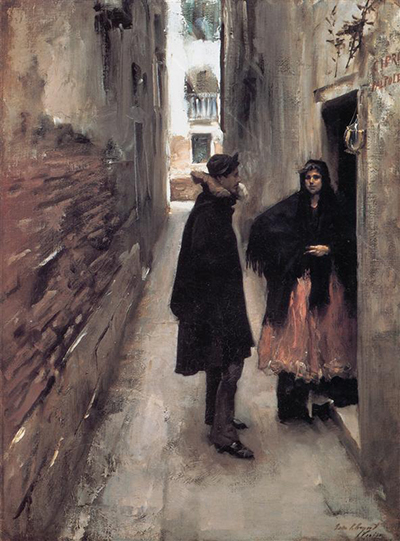A Street in Venice (1882) is a creation by John Singer Sargent (1856–1925) whose setting is a quiet backstreet located off the Calle Larga dei Proverbi which is near the Grand Canal in Venice. The painting depicts a young lady in a black robe strolling along the flagstones.
She appears to be kicking her long skirt with her right foot. Behind her, on her right-hand side, there are two men in the shadows indulging in a conversation while staring at her. The young woman’s face, with her downturned eyes, shows how insecure she feels because of the intrusive male glare. The painting is inspired by John Singer Sargent’s time in Europe. He spent most of his time in the streets of Paris. The composition’s mood has been linked with Margaret Conrads who was a writer that lived in Venice at around 1880. The painting is similar to other Sargent’s paintings which showed darkened streets with peripheral shadowy figures and buildings which were well lit at a distance.
John Singer Sargent used oil on wood in creating this painting. Its dimensions are 45.1 x 53.9 cm (17 3/4 x 21 1/4 in.) A Street in Venice was first showcased in 1882 at Galerie Georges Petit, located in Paris. The piece was sold in 1888 to Elizabeth Chanler of Boston who then gave it to the American architect Stanford White as a bargain for professional services. Later, in 1962, the painting was obtained by the National Gallery of Art in Washington DC. The painting has remained there ever since. The artist's paintings had a veteran city setting. However, his paintings greatly ignored the architecture Paris is known for. Instead, Sargent’s paintings focused on edgy backstreet imagery, which is definitely an influence of impressionism. Other features that are impressionistic are the brush strokes on the woman’s dress and the strange cropping of the painting.
Sargent admired Diego Velázquez, who is a Spanish master from the 17th century. The lessons he got from the early Spanish painter were greatly incorporated in Sargent’s paintings. The way the complex spaces were organized, and how he used rich, dark colours in his paintings, speak volumes of Diego Velázquez. Sargent’s work also captured a movement in a moment. This was particularly an influence from Carlo Naya (1816-1882), whose works were cropped in an almost photographic scene, just like Sargent’s.




